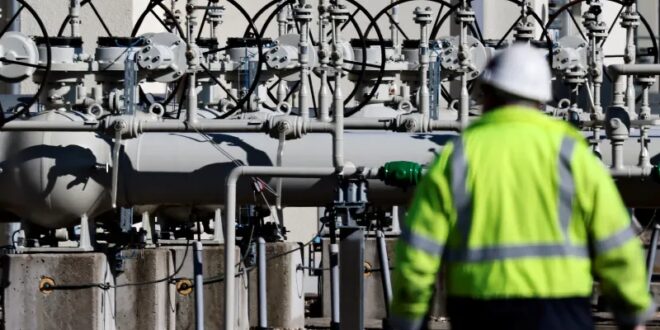Taming Volatile Oil Markets Requires a New Kind of Government Intervention
Oil is a volatile commodity. Even under ideal conditions, the price of crude changes by the minute, driven by any number of causes, such as shifts in national oil inventories and military coups in oil-producing states. Still, since the oil shocks of the 1970s, the global economy has generally managed this volatility. Oil is a crucial resource, and global economic interdependence has meant that meant that producers and consumers have typically shared the costs of sudden price changes. Through the early years of this century, as demand steadily rose, production increased to meet it.
Within the last decade, however, the volatility of the oil market has grown untenable. As the COVID-19 pandemic ruptured an already battered industry, governments and firms faced shortfalls in supply and uncertainty over future demand. Russia’s 2022 invasion of Ukraine pushed this volatility to an unacceptable level. Amid a radical disruption of Russian energy exports, prices skyrocketed—fueling the worst bout of global inflation since the 1970s. Alongside the challenges of a transition to renewable energy and a post–COVID-19 economic recovery, energy markets are now in constant flux.
This unstable situation should shake Washington from its longstanding complacency. For too long, the United States has failed to regulate its domestic oil industry or take effective measures to manage the global market. To handle future shocks and mitigate the threat of climate change, policymakers in the United States and its allied capitals must do much more to stabilize prices and facilitate a long-term shift away from fossil fuels. Oil has been out of control for too long. It’s time to set some new rules.
LOSING CONTROL
Since the Industrial Revolution, the global economy has depended on the flow of energy commodities to sustain industrial activity and maintain living standards. In the nineteenth century, economic activity centered on coal; later, it revolved around oil and natural gas. Few countries possessed the energy resources they needed to be fully self-sufficient, and most found the steps to achieve and maintain such self-sufficiency excessively burdensome. As a result, over time, all states became exposed to, and increasingly relied on, the flow of energy commodities through a global market.
The modern global energy market took shape after World War II, as the United States established a new economic order and facilitated the reconstruction of war-torn western Europe and Japan. Between 1949 and 1970, oil consumption rapidly increased worldwide, rising in the United States, from 5.8 million barrels per day (bpd) to 16.4 million bpd, and in western Europe and Japan, from less than one million bpd to 18 million bpd. Despite surging demand, this market was relatively stable, and price shocks were rare—in part because the United States, the world’s largest oil producer, retained enough spare capacity to meet demand during an emergency. Moreover, a small group of major Western oil companies, including Exxon, BP, Shell, Chevron, and Mobil, controlled the global oil market, including the prolific oil fields of the Middle East. This dominance meant that large firms could operate as an oligopoly—keeping prices relatively stable through the 1960s.
As a result, interruptions to the oil supply rarely caused serious economic damage. In 1951, for instance, Iran nationalized its British-owned oil industry. In retaliation, the United Kingdom embargoed Iranian oil, refusing to accept imports until Tehran reversed its policy. Initially, the United States and its allies were concerned that the crisis would create shortages in the global economy, since Iran supplied seven percent of the world’s crude oil and five percent of its refined products. But because the big Western firms controlled oil fields outside Iran, they could make up the shortfall by simply increasing production in Iraq, Kuwait, and Saudi Arabia. Within two years, Iran’s efforts to nationalize its oil production had been reversed by a military coup d’état, assisted by the U.S. and British governments.
For too long, the United States has failed to regulate its domestic oil industry.
By the 1970s, however, changes in the global oil market and international politics began undermining this once stable system. During the 1973 Arab-Israeli war, Arab countries, which at that time produced a quarter of the world’s oil supply, embargoed the United States over its support for Israel. Seizing control of their industries from private Western companies, Arab governments, led by Saudi Arabia, cut output by 20 percent between October 1973 and January 1974, causing global supply to fall far below demand. By this point, the United States had no spare capacity to draw on, and Americans faced severe gasoline shortages during the winter months of 1973–74. Washington responded with a rationing program, prompting several months of long lines at gas stations. At the same time, members of OPEC—the organization of oil producers that controls prices by setting production quotas among its members—increased the index price for their oil exports from $3 to $12 per barrel, quadrupling the market price in a matter of months.
The resulting price shock had a profound economic impact. The United States suffered a recession between 1974 and 1975, western Europe and Japan were forced to cut back on energy-intensive industrial activity, and rapid increases in oil prices helped create global “stagflation”—a combination of slow growth and high inflation that endured through the rest of the decade. The developing world was hardest hit, as many states lacked both domestic sources of oil and the financial resources of the industrialized West.
By the end of the decade, global energy markets were in turmoil. Western companies were no longer able to influence supply, nor was OPEC able to manage the rising prices that its policies had created. Geopolitics also played a role: in the 1979 Iranian Revolution, the pro-Western regime was overthrown and replaced by the anti-Western Islamic Republic. A year later, Iraq invaded Iran. These events triggered yet another price shock, and the threat of violence loomed over the oil fields of the Persian Gulf for the next 40 years, adding more uncertainty to the flow of global oil.
THE SHOCK YEARS
The 1970s oil shock fundamentally altered the global energy system, laying the groundwork for future instability. Unlike in earlier decades, when private companies could moderate the price of oil, it now fluctuated on a global market that was no longer under Western control. The group of countries that supplied the international market also became much more diverse as new entrants such as Angola, Brazil, China, Equatorial Guinea, Kazakhstan, Malaysia, Norway, and the United Kingdom joined historic producers in OPEC, Russia, and the United States. These developments widened and complicated the impact of shocks, which became much more frequent and less predictable.
In some cases, these shocks reflected a geopolitical event, such as Iraq’s 1990 invasion of Kuwait, which, like Iraq, was a major oil-producing country. The war increased the so-called geopolitical risk quotient—the value added to oil when supplies are at risk from potential violence—causing the price of oil to spike from $15 per barrel to $35 per barrel. Although oil supplies remained relatively stable thanks to increased production in Saudi Arabia and other OPEC member states, the shock contributed to a slowing global economy in 1990 and a recession in 1991 caused by the increased cost of energy.
In the late twentieth century, volatility ran in both directions, however. Negative shocks—crashes in the price of crude—occurred whenever demand contracted or supply exceeded demand, as in 1985–86, when the price of oil dropped from $27 to $10 per barrel because of Saudi Arabia’s decision to increase production and seize market share from other producers. The fall in oil prices weakened the Soviet Union, which had become dependent on oil exports, and was a crucial factor in ending the Cold War. At the end of the 1990s, the Asian financial crisis led to another collapse in prices, as a series of financial shocks ripped through the region and slowed global economic growth. Although cheaper oil was a boon to consumers in Western countries, the shock instigated a financial crisis in oil-producing countries such as Brazil and Russia.
Despite this increasing volatility, demand for oil rose sharply between 1990 and 2008, driven largely by expanding economic growth in the developing world, especially in China, where demand rose from 4.1 million bpd in 1999 to 13.5 million bpd in 2018. As a result, investments in oil infrastructure boomed, and in 2008, prices soared above $100 per barrel for the first time in history. Although the financial crisis and recession of 2008–9 caused prices to slump, they quickly recovered and in 2011 increased to $110 per barrel. Prices remained at or near $100 for the next three years.
THE LAST CRASH
In 2014, the oil market experienced yet another crash, collapsing from $140 to $50 per barrel in about a year. The reasons for the drop appeared straightforward: as demand in China and elsewhere slowed for the first time in a decade, new supplies from the United States, facilitated by technological advances such as hydraulic fracturing, or “fracking,” glutted the market. For the next five years, oil prices remained low, helping stimulate a prolonged period of expansion in the global economy, as cheap energy led to rapid growth and helped the United States and Europe accelerate their recoveries from the economic crisis.
Still, this slump in oil prices had several serious and long-lasting consequences. First, it produced an environment of uncertainty in the oil industry, which lost billions when boom turned to bust. Although oil supplies recovered, capital expenditure by major companies remained sluggish. This slowdown stemmed from a second consequence of the shock: growing fears among oil executives that demand was likely to decline in the long term. Following the 2015 Paris climate accord, most nations agreed to reduce their carbon emissions. Pressure from investors and the public forced most oil and gas companies to make similar commitments. Energy firms and consultancies began speculating that the global economy would hit “peak oil demand” sometime in the next decade as renewables and electric vehicles reduced the need for fossil fuels.
The 1970s oil shock fundamentally altered the global energy system.
Finally, the 2014 shock caused or corresponded with an overall reduction in global oil supply. The collapse in prices created political and economic chaos in Venezuela, and the country’s production fell from two million bpd to 400,000 bpd between 2016 and 2020. In 2018, the United States reimposed sanctions on Iran’s oil exports in an attempt to constrain the country’s nuclear program, removing over one million barrels from the global oil market. Over the same period, oil production in Iraq, Libya, and Nigeria also declined or stagnated from a lack of investment and unstable geopolitical conditions.
At the time, the loss of these supplies and underinvestment in new oil production received little attention. Such developments seemed even less important when the COVID-19 pandemic hit in early 2020, dramatically reducing global fossil fuel consumption. Yet the full effects of the 2014–16 shock and its aftermath became apparent when countries began to rebound from the pandemic and global economic activity picked up again in 2021, revealing a deeply unstable environment primed for another major period of volatility.
WAKE-UP CALL
Unlike past crises, the pandemic-induced 2020 oil shock was the result of government intervention. As major economies went into lockdown to mitigate the spread of COVID-19, oil prices fell from $70 to $15 per barrel between January and April 2020. When governments subsequently lifted lockdown measures in 2021, demand quickly recovered, and prices began to tick upward again.
Economic warning signs emerged almost immediately. During the summer of 2021, oil and natural gas inventories lagged well behind historical averages as surging economic activity caused demand to outstrip supply. This gap had structural roots: after experiencing two shocks in a single decade and now fearing declining demand, private oil companies were wary of investing in new production. Separately, many oil-producing states were more intent on raising prices than on increasing production in an attempt to recoup pandemic-induced losses, and many OPEC member states had difficulty resetting production levels after the COVID-19 crash. Finally, companies eager to shed unprofitable assets deactivated multiple oil refineries when demand slumped during the COVID-19 pandemic, reducing global refining capacity by three million bpd. The result was a market primed for another extended period of instability.
Then, in February 2022, Russia’s invasion of Ukraine brought this precarious system crashing down. When Western governments imposed sweeping sanctions on Russia’s economy, global oil prices shot from $90 to $120 per barrel, fueling the worst bout of inflation since the 1970s. Making the situation even worse, an already tight market grew tighter as OPEC maintained production limits and U.S. firms refused to invest in new production in the face of spiraling costs and uncertain demand. Refinery capacity lost during the first years of the COVID-19 pandemic also caused a historic spike in domestic gasoline prices, which exceeded $5 per gallon in June 2022. Outside the United States, the shock produced a host of crises, including high consumer prices in western Europe and economic collapse in Sri Lanka, where the cost of energy imports drained foreign exchange reserves. Other energy-starved states across the developing world were similarly affected.
TAMING THE MARKET
Russia’s war in Ukraine has done more than scramble the already volatile energy market, however. It has also revealed confusion among Western leaders and major oil-consuming countries about how to manage energy shocks while still addressing the looming threat of climate change. The G-7, for instance, has discussed abandoning its 2021 commitment to stop financing overseas fossil fuel projects, and many European countries have restarted previously shuttered coal-fired power plants over fears of a Russian natural gas shutdown.
In turn, climate advocates have called for a speedier transition to renewable power, touting green energy’s security advantages. But barriers to new climate-friendly investments are nearly as steep as those facing oil, given the rising costs of raw materials needed to construct new wind turbines, solar panels, electric vehicles, and lithium batteries. As a result, political and economic forces in the United States are now pulling President Joe Biden in two directions—he must urge U.S. companies to invest in more oil production on the one hand and retain a rhetorical commitment to an energy transition on the other.
Despite these tensions, the United States has an array of policy options at its disposal. To bolster its energy security and smooth the transition away from fossil fuels, Washington should take a more assertive approach to managing the oil market. Suspending the Jones Act—a law that prevents foreign vessels from carrying fuel between U.S. ports—for instance, could reduce energy prices in the United States by decreasing transport costs. Biden could also use additional timed releases from the Strategic Petroleum Reserve to help stabilize prices. Simultaneously, Washington could use the Defense Production Act, a Cold War–era law that allows the government to mandate industrial production in the name of national security, to reduce bottlenecks and shortages of key materials needed to expand energy production, such as steel pipe and fracking sand. Biden could also pair these measures with a program to subsidize oil refinery operations. Such a policy would ensure that adequate capacity exists to meet domestic needs, even during a crisis. Finally, to encourage new investments, Washington could offer security to owners of oil and gas assets, backstopping their investments to ensure that they stay in business in the event of an emergency.
Washington must take a more assertive approach to managing the oil market.
At the same time, the U.S. government should take a long-term approach to increasing renewable energy production and reducing domestic fossil fuel consumption. Here, too, Washington has a variety of available tools. For one, Biden could boost domestic investment in wind and solar power, including by increasing the number of offshore leases for wind turbines. Offshore wind is in the early stages of development on the U.S. East Coast, and the first leases for the West Coast were proposed in May 2022. The United States could also work to implement a carbon tax or offer tax incentives for nonfossil fuel energy utilities. Such policies would help steer private investment into renewables, along the lines of Biden’s 2021 Build Back Better plan, making clean energy more competitive and popular over the long term. Additionally, Washington could increase its support for investments in the raw materials needed to manufacture electric vehicles, wind turbines, solar panels, and batteries. These measures could include simplifying guidelines for opening and operating new mines and using Defense Production Act funds to offset costs.
After the crises of the 1970s ended a period of market stability, governments did little to mitigate the risk of oil price shocks. Instead, they surrendered to a volatile market that seemed beyond their control. As Megan L. O’Sullivan and Jason Bordoff have argued in Foreign Affairs, this situation is likely to change; greater state involvement in energy policy will be a major outcome of the current price shock. For energy-consuming Western countries, such a shift is necessary—both as a way of improving energy security and as a means of meeting the looming threat of climate change.
To be sure, a laissez-faire attitude toward energy markets played a major role in four decades of economic growth. But a new era requires a new approach. Steering clear of future shocks on the scale of the 2014–16 price collapse, the COVID-19 pandemic, and Russia’s invasion of Ukraine requires active management. To avoid new crises and facilitate a smooth transition away from fossil fuels, the United States and its allies must develop a coordinated and strategic approach, driven by state power, to manage the flow of energy and tame oil’s volatility.
 Eurasia Press & News
Eurasia Press & News




